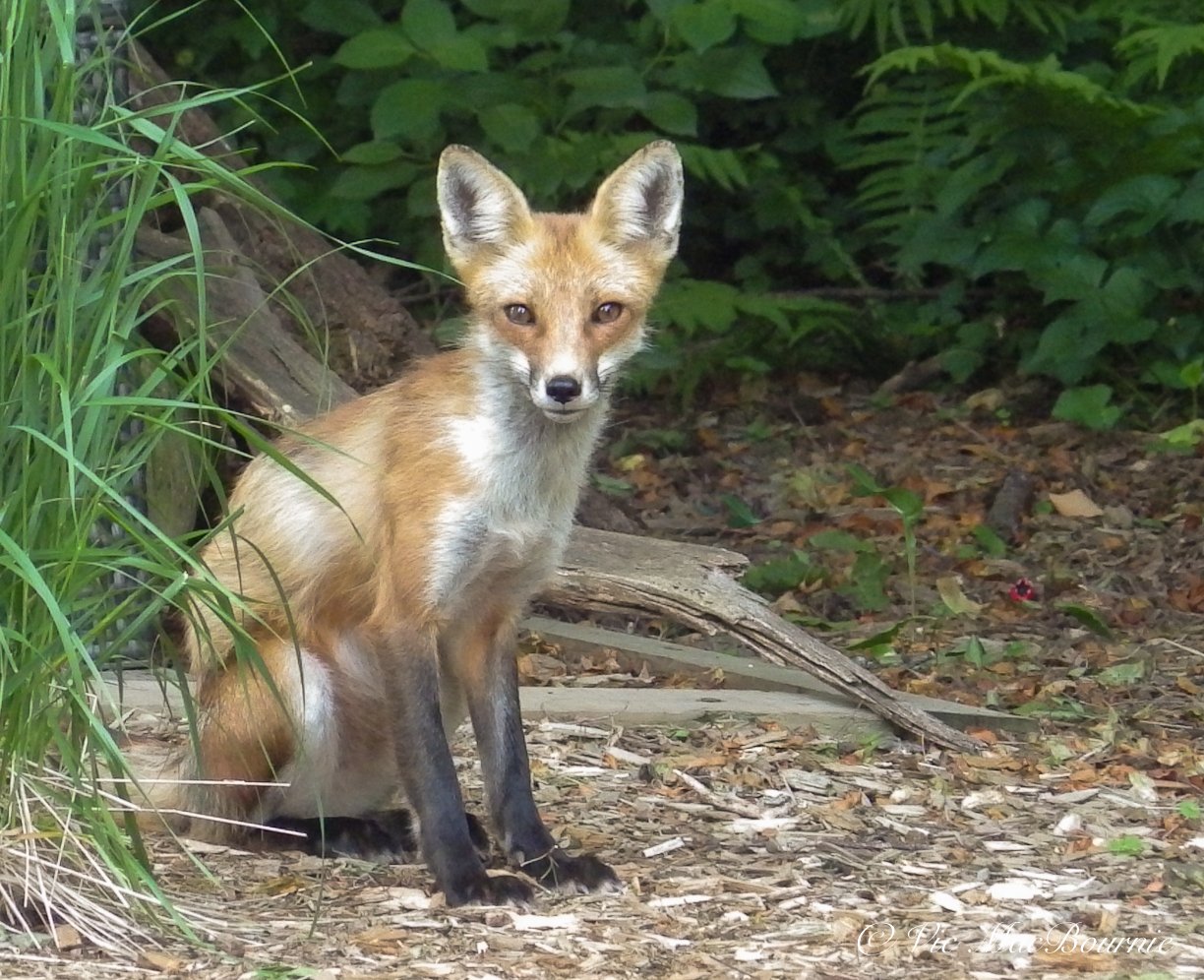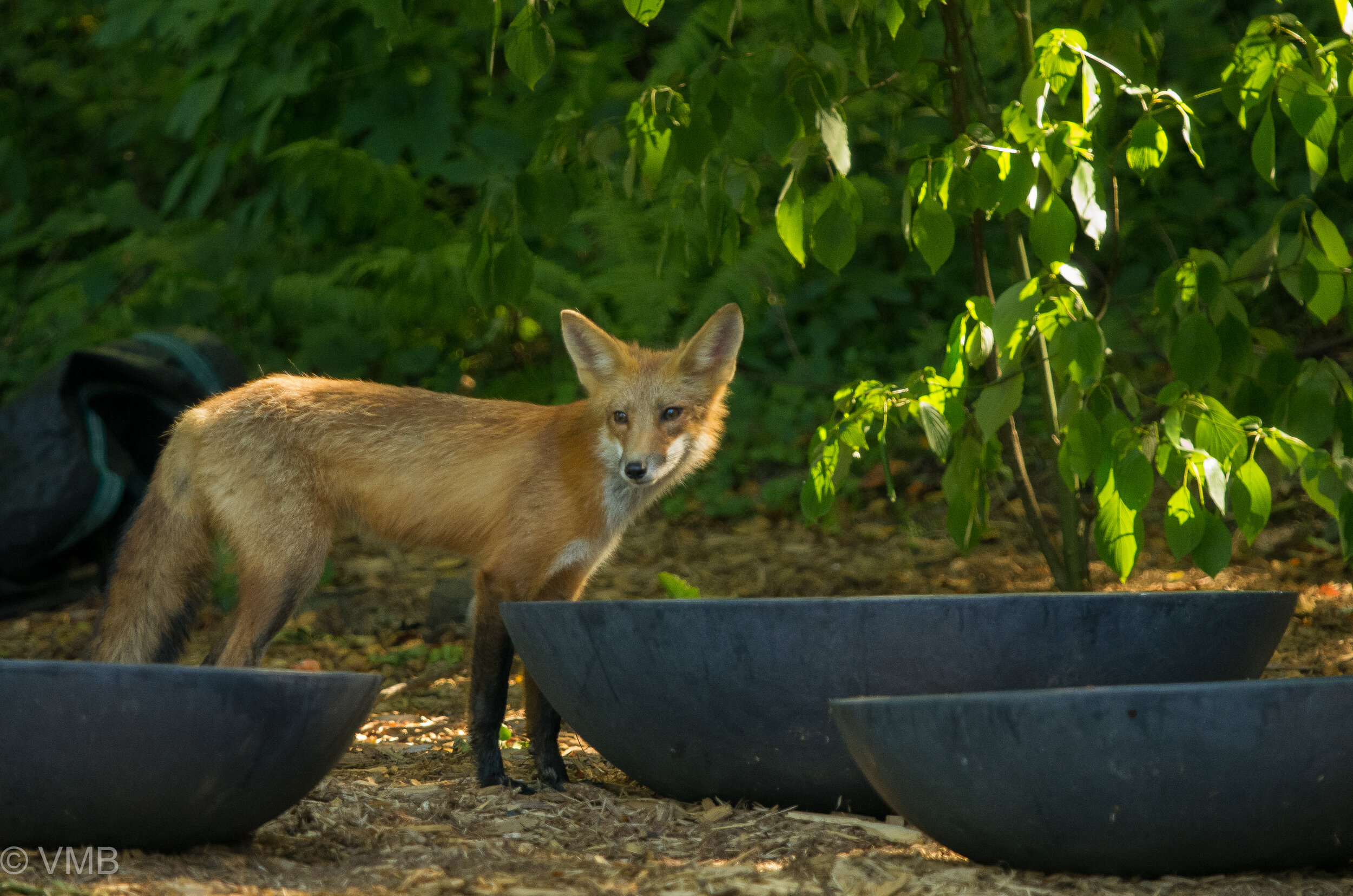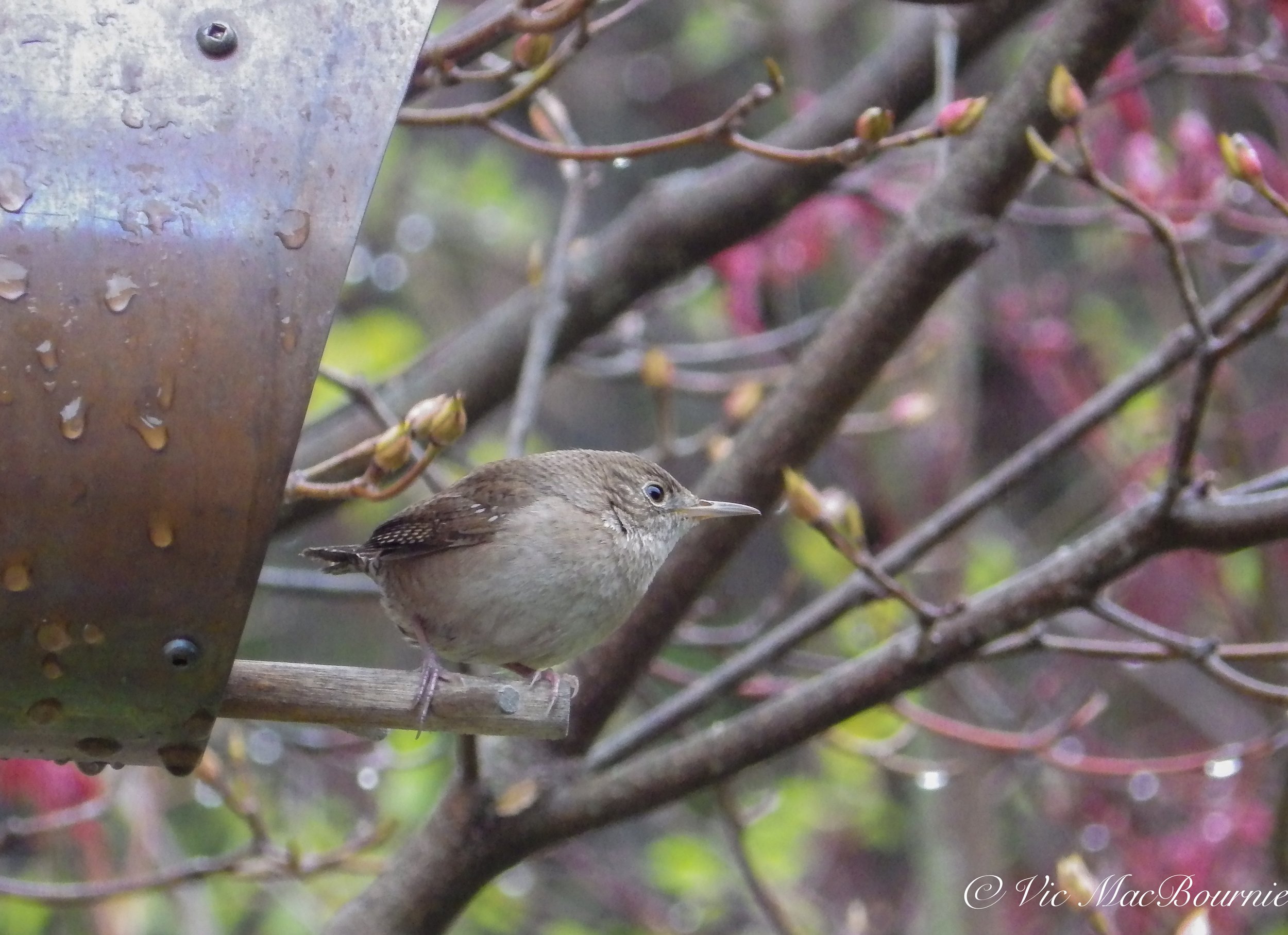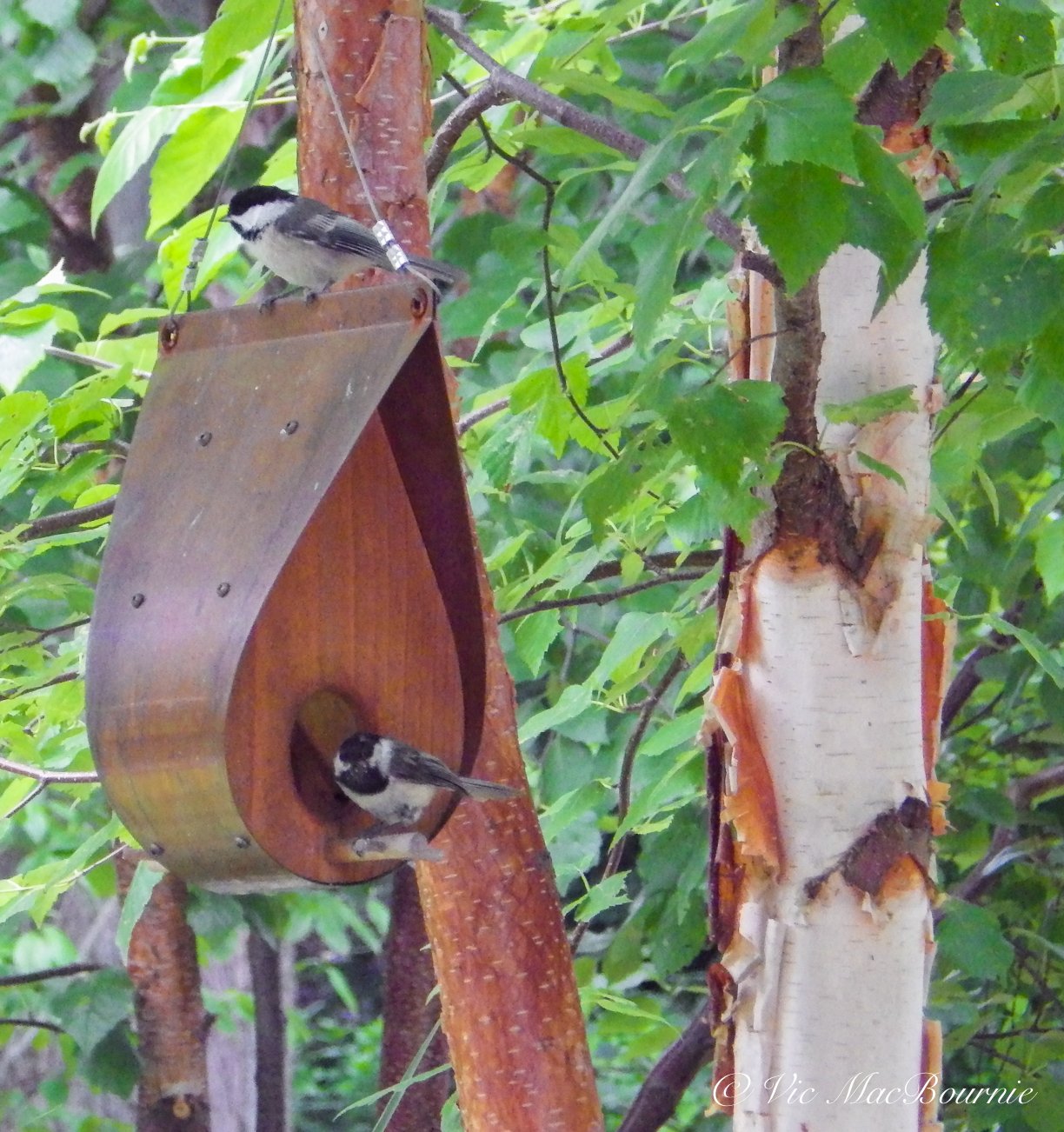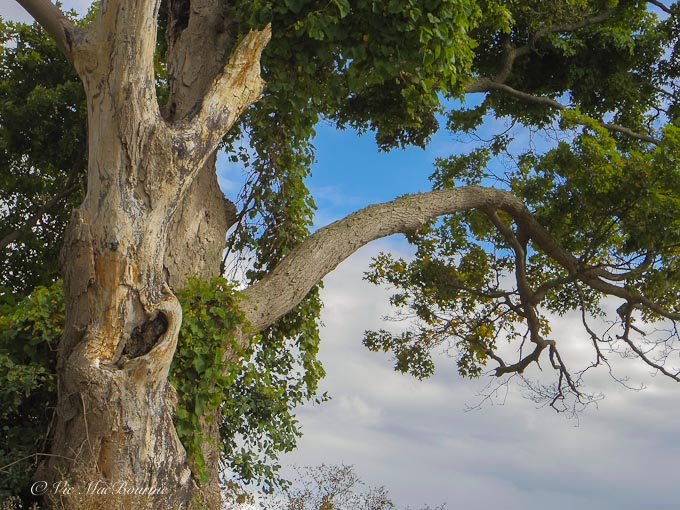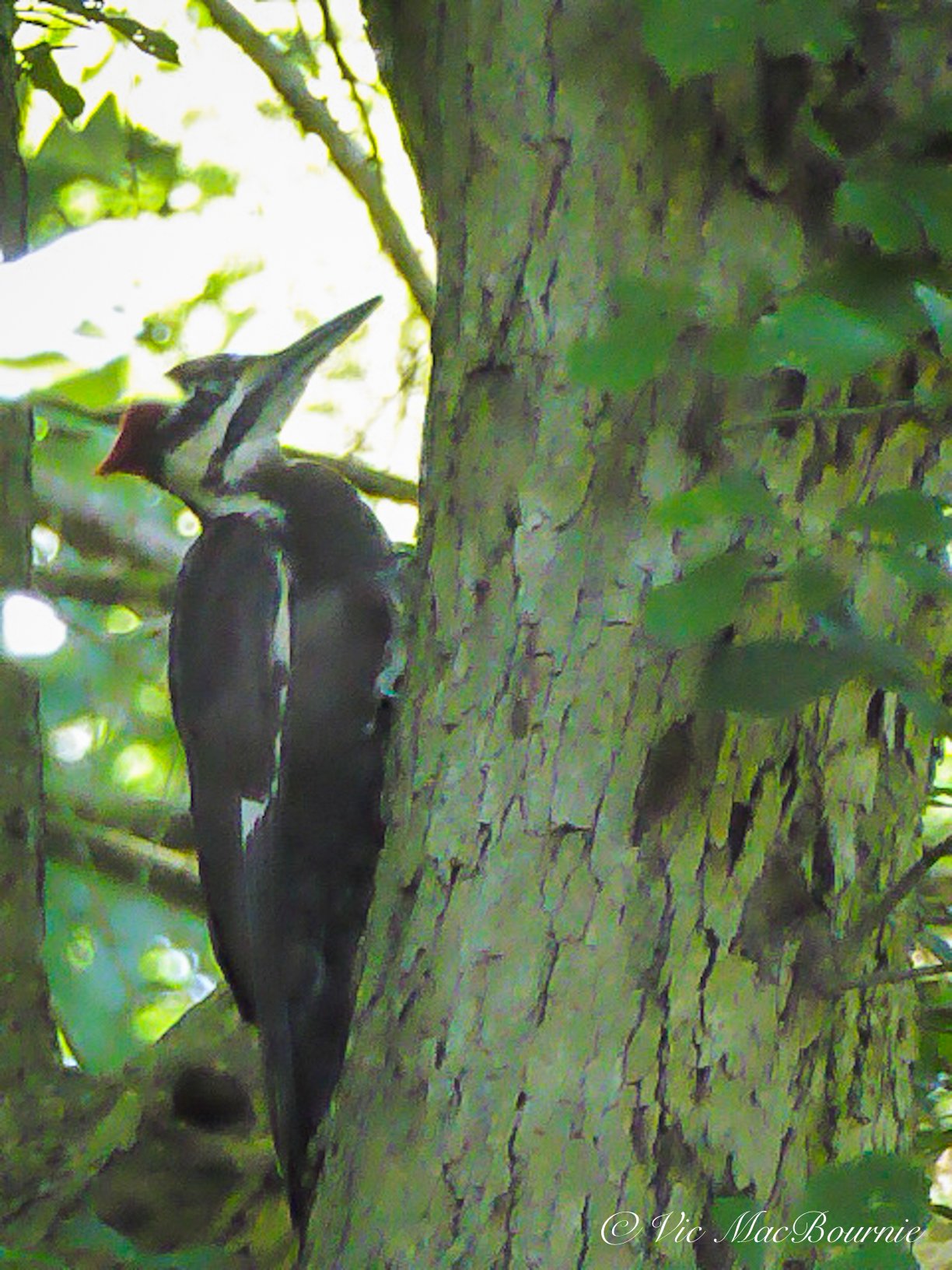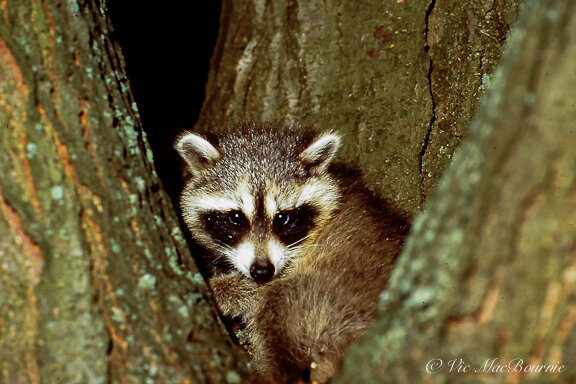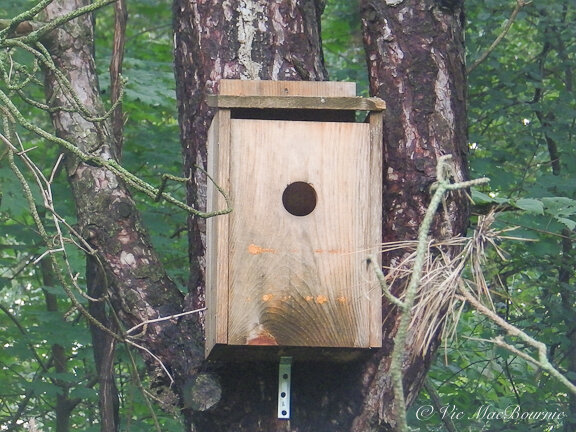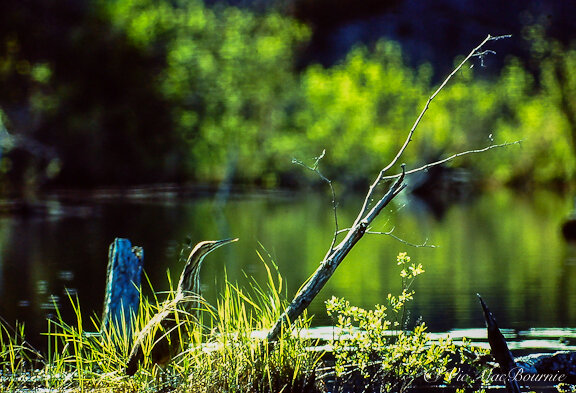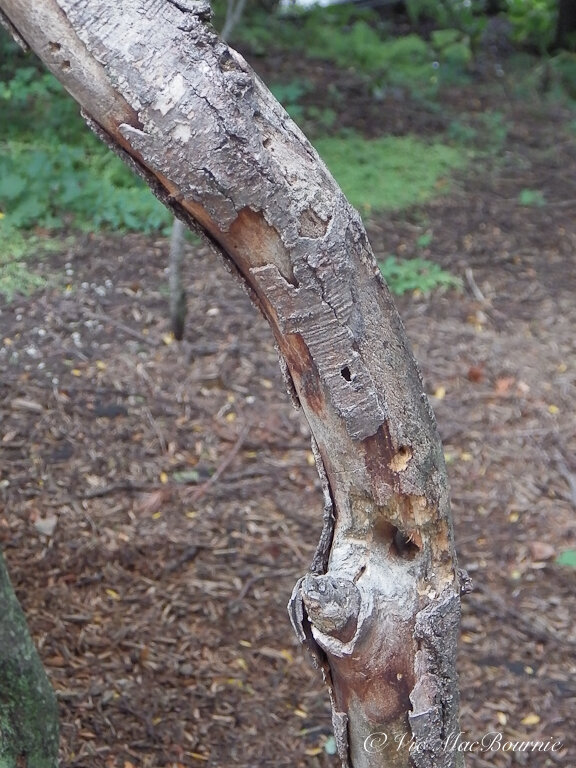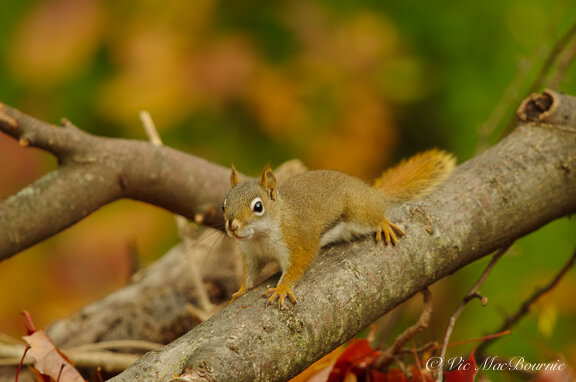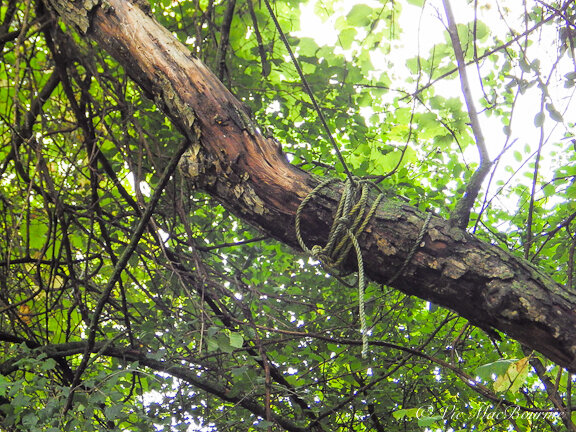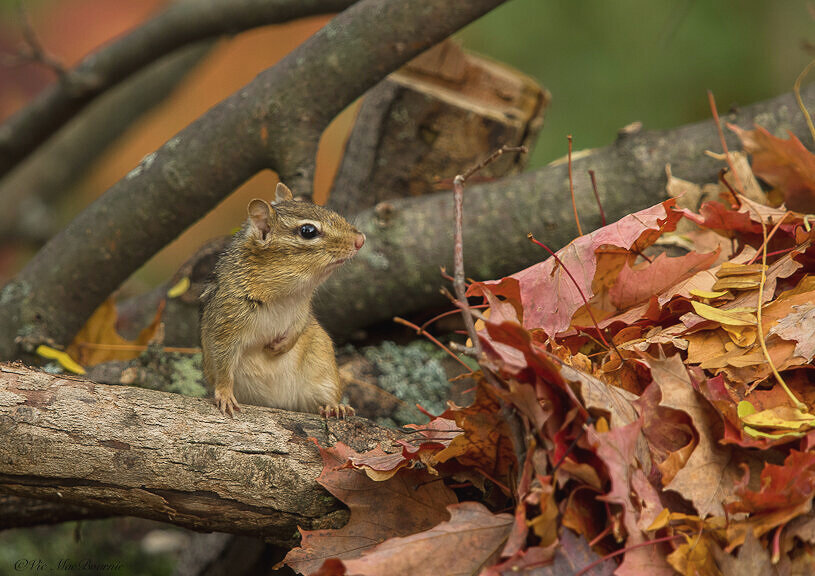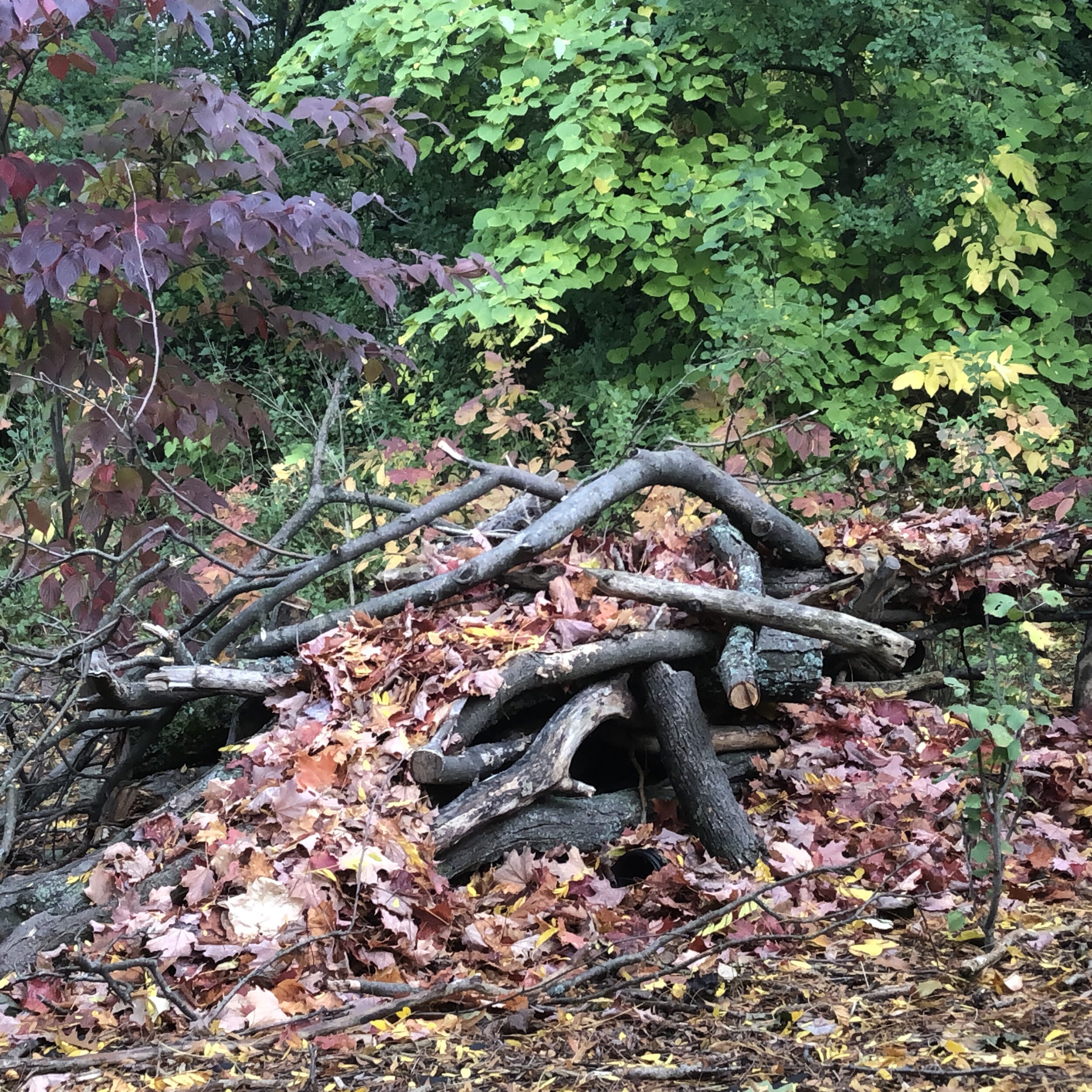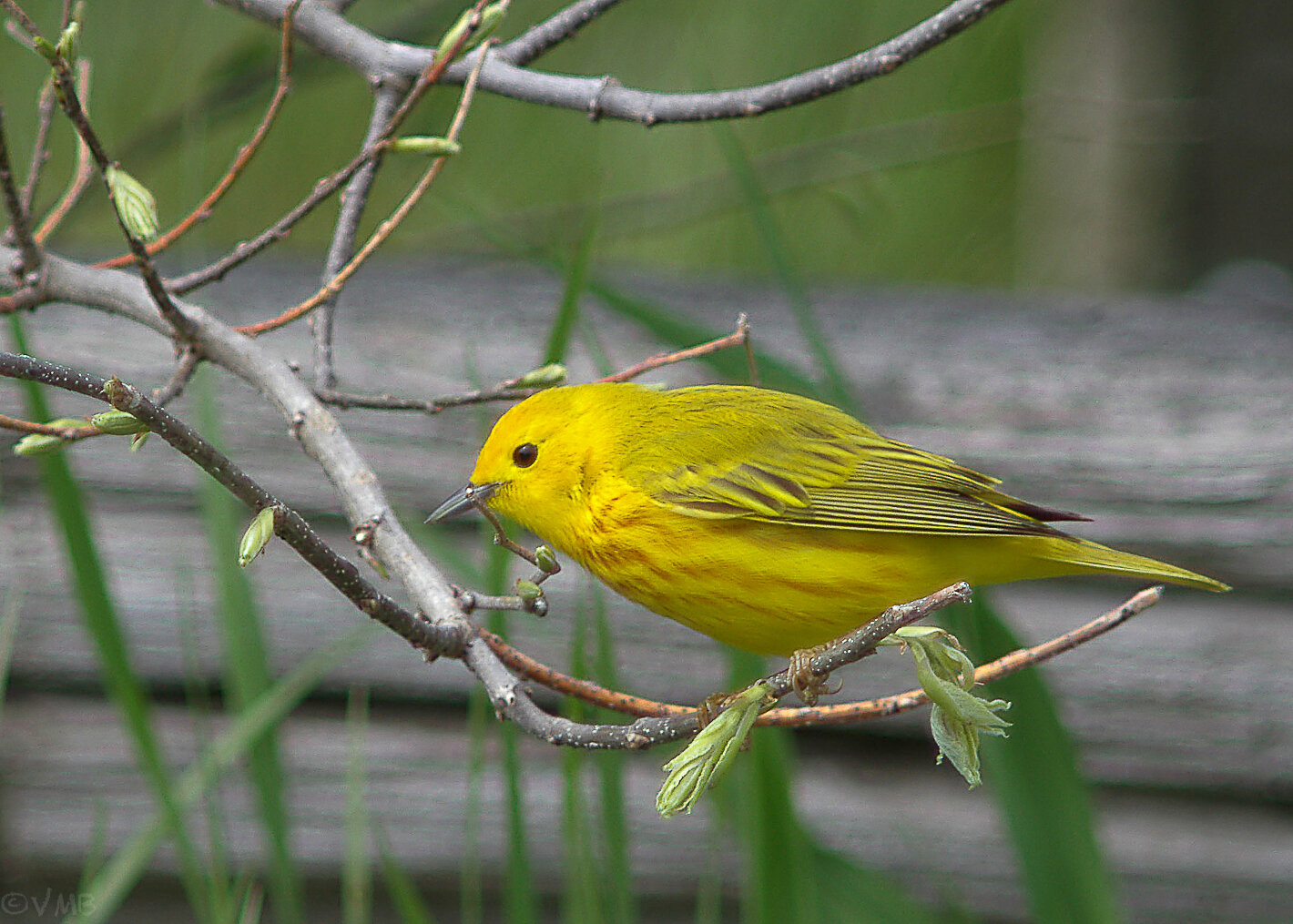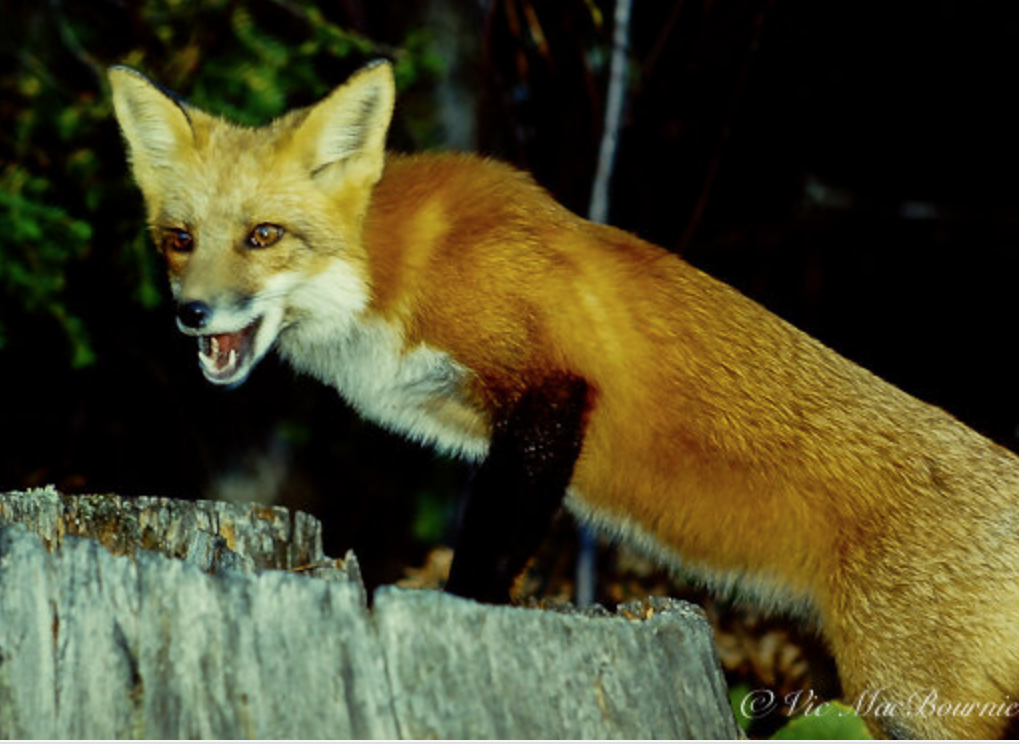Tips to photograph wildlife in your woodland garden
Creating the right environment to be successful in the garden involves a lot of hard work. But, in the end, it pays off. It’s not luck that you saw an oriole, a fox or hummingbird in your garden. It’s the result of that hard work you put in earlier to create the right conditions.
Bridge camera can be best choice for garden photography
One of our neighbourhood foxes dropped in for its daily visit. It helped that I was armed with my camera on a monopod and my favourite lens.
This fox image is an example of how the right environment created an opportunity to capture an image that presented itself.
It began with a decision to work on getting a good image of a hummingbird feeding at a native Cardinal flower, but ended hours later with a memorable image of a fox.
Let me explain.
The cardinal flower was at its prime and I knew that, if I wanted to use it to get an image of a hummingbird feeding, I needed to act swiftly. So I set the camera on a tripod, filled up my coffee and waited.
(If you are interested in exploring garden photography at a higher level, be sure to check out my comprehensive post on the Best camera and lens for Garden Photography.)
If you are looking for a new camera or lens, check out B&H Cameras & Video for a complete line of cameras and lenses.
And, if you are wondering how a point-and-shoot digital camera that’s more than 10 years old can perform in the garden, be sure to check out my post on the Canon PowerShot Elph 500 HS.
The hummers came to the feeders surrounding the Cardinal flowers but only stopped at the flowers three times for a brief moment.
About three hours into the shoot, I noticed a fox standing by our shed looking my way. It was by no means stressed by my presence. In fact, it seemed perfectly happy to share the yard with me provided we stayed at a comfortable distance.
How often have you been in the yard and a great photographic opportunity presented itself to you? Too often, we are not prepared. Chances are, all we have is our smart phone by our side and the resulting image is nothing but a poor replica of a memorable moment.
But on this day I was in luck. The camera was already set up with my favourite 300mm F4.5 lens on a monopod.
I couldn’t ask for a better situation. Even our dog Holly had yet to notice the fox that trotted over to our three large water bowls and helped herself to a long drink.
A few quick bursts of photos from the 35mm DSLR camera and off she went. Like a ghost. There one moment … the next, gone. It was over as quickly as it began.
The lesson learned was simple: Be prepared.
Today, even if I just go out to enjoy my morning coffee, I always have a camera by my side ready for action. Sometimes it’s a simple “Travel camera” (read my travel camera review here) with a wide angle to short telephoto lens that is great for basic garden shots but will not likely get you close enough to most wildlife.
If you are looking to upgrade your camera equipment – be it a new camera body or lens – be sure to check out KEH Camera Exchange for the best prices on excellent used equipment. You can also trade in your used gear to help curtail the cost of new equipment.
Most likely, it is my versatile “Bridge camera” that allows me to shoot everything from long telephoto images of wildlife, including birds and butterflies, to sweeping wide-angle garden vistas, to macro shots of flowers and insects.
On this day, I happened to have my 300mm lens on the camera and ready to go, which made capturing the fox image possible.
This young fox decided to pose for me for a minute giving me time to focus the Pentax X5 “Bridge” camera to capture the image. I needed to use the full zoom power of the X5 (500mm) to capture the image.
More recently, however, I have a “bridge camera” with me. I have used the camera for more than a year now and have come to appreciate its versatility, with its ability to go from extreme telephoto to wide angle and even a very usable macro mode.
Bridge cameras, which are offered by all the major camera manufacturers, can be the perfect camera choice for garden photographers looking for a single extremely versatile camera that is at home photographing garden vistas as it is birds and other wildlife. Add to that versatility the ability to get in close to flowers for macro photography and it’s hard to believe that everyone is not lining up to purchase one. These cameras can be described as mid-priced cameras situated between a simple point-and-shoot and a more serious 35mm SLR with a complete line of lenses. Bridge cameras look like a typical digital single lens reflex (DSLR), but without the interchangeable lenses.
The bridge camera offers a built-in lens sporting a wide angle to long telephoto lens. The combination creates an easy-to-carry-around versatile camera that can deliver very good results with a little practise.
But they are not by any means perfect.
My bridge camera uses an electronic viewfinder in addition to the back LCD screen to view the image. The electronic viewfinder takes getting used to and falls far short of a optical viewfinder found in traditional DSLRs. To add to the difficulty of using the Bridge camera is a significant “shutter lag” meaning an excessive amount of time between when you press the button to take the image and the time it is actually taken. This shutter lag can mean the difference between getting the shot and missing it entirely.
In addition, because most of these cameras are so dependent on electronic viewfinders and the electronic zooming of the lens, some of these cameras tend to exhaust your batteries quickly, especially if you use the large back LCD screen as your primary viewer or to check your images regularly. My camera uses regular AAA batteries, which can be convenient when you are travelling, but compared to rechargeable batteries, can also be expensive to use. The other issue I have with the Pentax (which is no longer available) is the fact I cannot easily add filters to the front of the lens. This may not be a problem for most photographs, unless of course, you need to use a polarizing filter to remove glare from leaves or a pond.
Like most Bridge cameras, the Pentax X-5 bridge camera that I am using came with a very long 26X telephoto lens (the equivalent zoom for traditional 35mm cameras of about 22-580mm.) Most bridge cameras come equipped with a lens that provides the photographer with both a solid wide angle lens as well as a super-long telephoto lens.
Bridge cameras like my Pentax X-5 also come equipped with an impressive macro feature making it the perfect camera to carry with me into the garden for casual macro shots. For more serious macro photography, I will mount a 50mm or 100mm dedicated macro lens on a 35mm SLR camera.
Being prepared, having the right tools at hand and, of course, some luck on your side can mean the difference between getting the shot and missing it.
Even seeing wildlife, let alone getting good photos of them, depends on a lot of factors going your way.
Luck certainly plays a role in any shot, but I like to think that it plays a smaller role than most people think.
A macro image of a clematis taken by the Pentax Bridge camera the X5, on macro mode. This shows the versatility of the camera and its lens that is able to go from long telephoto (see above image of the Fox) to extreme macro without changing the lens.
Being out in the yard for more than four hours patiently waiting for the hummingbirds to cooperate creates the opportunity to be successful. Still, I was unsuccessful getting that shot of the hummingbird. Instead, I had to “settle” for the fox shot.
I like to think you create your own luck.
Setting out large water bowls meant to provide local wildlife with a fresh water source helped create that opportunity for the photograph.
Creating a natural garden, providing a source of natural food and moving water in the form of bubbling rocks and fountains, not using pesticides, having woodpiles … these all provide the right environment to getting the photograph, or the opportunity to observe the wildlife that call our property home.
PopPhoto website lists their favourite Bridge Cameras in this informative article starting with the best overall camera going to the Sony Cyber-shot DSC-RX10 IV, the Canon PowerShot SX70 HS as the best Wildlife camera and the Panasonic Lumix FZ80 as the best budget camera.
It doesn’t have to be a fox. It could have been a bird, a butterfly a reptile, or even a photograph of a beautiful tree or grouping of flowers.
The day before this shot was taken, I was trying to capture some photographs of birds enjoying my new solar-powered fountain, when a little chipmunk decided to hang out with me for a while. So I got “lucky” and was able to get some great shots of the chipmunk too.
Getting lucky is really about creating the right environment to get photographic opportunities and then taking advantage of these opportunities.
It’s the same in your everyday life. Put yourself in the best environment to succeed and chances are you will.
Getting up early, spending time in our gardens, getting up close and intimate with flowers. These all create the opportunities to be successful.
I’ll be out again soon working on getting the shot of the hummingbird at the cardinal flower. Maybe I’ll get “lucky” and the hummer will cooperate this time.
This page contains affiliate links. If you purchase a product through one of them, I will receive a commission (at no additional cost to you) I try to only endorse products I have either used, have complete confidence in, or have experience with the manufacturer. Thank you for your support. This blog would not be possible without your continued support.
Do NOT cut down that dead or dying tree
If you are lucky enough to have a dead or dying tree in your yard, do everything you can to protect it. The birds, animals, insects and fungus will thank you for it. Beautiful trees might be wonderful in our gardens, but dead and dying trees are more important to many birds and animal life.
Create your own “wildlife tree” in the backyard
A tree growing beautifully in your woodland is wonderful, but to birds, bugs and other backyard critters a dead or dying tree is even better.
If you have a dead or dying tree in your yard (often referred to as a “snag”) consider doing everything possible NOT to cut it down. These trees are just too important to the local wildlife to cut down for no reason than it has succumbed to the ravages of time or disease. The dead tree will quickly become a magnet for important birds, insects, and microbial fungi that might not already be present in your woodland garden.
Woodpeckers, warblers and other insect eating birds will find the dead tree irresistible and over time use it as a resource for food and possibly a home to raise their young. Depending on where you live, small mammals like raccoons, skunks, martens and even porcupines might decide to take up residence in your “wildlife tree.”
This Pileated Woodpecker was photographed working on a dying tree in a back corner of the yard.
The snags can even become more important in winter where birds that depend on insects for survival look to the snag as a source for insect, larvae and other potential food sources. During winter, birds, bats and other small animals will often roost behind the loose bark and large cracks in the wood for both warmth and shelter.
Studies show that in areas of the United States West of the Cascade Mts, 39 species of birds and 14 species of mammals depend on tree cavities for survival. Similar numbers (39 bird species and 23 mammal species) East of the Cascade Mountains depend on snags. (USDA Forest Service)
The wildlife tree is the perfect “snag” with vines beginning to climb up the trunk and natural nesting cavities.
Of course, if the dead or dying tree poses a significant danger to either individuals or your home, steps should be taken to ensure the situation is made safe. This does not, however, automatically mean that the tree needs to be cut down.
There are options to save many of these trees that we will discuss later in this article.
Unfortunately, most snag or “wildlife trees” are too quickly cut down by homeowners, city parks and even within urban forested areas for fear of injury.
These trees are too often cut down without much thought, if any, to their wildlife value or of the potential options that could save all or most of the trees to live on as an important wildlife tree.
Many of our backyard animals depend on snags for both nesting and living accommodations as well as foraging for food.
Why preserve a dead or dying tree?
The dead trees, especially larger ones, provide optimal habitat for woodpeckers and other primary cavity nesters. In fact, large snags from mature trees are critical for big birds such as Pileated woodpeckers that require more available internal space for raising their young.
Woodpeckers such as the Pileated or Northern flicker actually create several new cavities in dead and dying trees per year. Many of the cavities are started by the woodpeckers for possible use in future years, but in the meantime, are often used by smaller bird species.
The woodpeckers will often start the cavities in areas of the tree that is weakened and then leave to allow nature to finish a lot of the hard work.
Fungus eventually invades the cavity and softens the wood over time. The following year, the birds may return to continue hollowing out the cavity’s internal wood, which has now become softer and easier to excavate.
Wildlife tree
Can’t you just imagine a large eagle sitting atop this old snag scouting the area for its next dinner? It’s more likely home to an owl along with a host of smaller birds, bugs and other critters.
Woodpeckers, in turn, create habitat for more than 80 other species of secondary cavity nesters, including American kestrels, a host of owls from the diminutive Screech owl to Barn owls, Barred owls and even Great Horned owls, swallows including the tree swallow and purple martins, bluebirds and a host of wrens, chickadees and nuthatches.
Owl box on pine snag
A screech owl box on this dying fully mature pine tree provides and opportunity to attract the diminutive little predator even if you do not have a large enough dead tree in your yard.
What do all these birds have in common?
They are primarily carnivorous or insect-eating birds that will help to naturally control mice, rats and insects in your garden. Without them, your garden can easily get out of ecological balance. In fact, many urban gardens, where dead or dying trees no longer exist, are overrun with mice and rats and skunks in part because of a lack of nesting cavities in the area for higher predators. Great Horned Owls, for example prey on skunks.
If your area has few if any natural snags, it may be the perfect time to look into installing screech owl boxes that provide nesting opportunities for these small, but highly efficient mice and rat controllers. If attracting screech owls sounds interesting, check out my full article on installing screech owl boxes in your garden, go here.
Even small snags are vital to wildlife
This American Bittern was attracted to this fallen snag in a pond. A dead or dying tree, whether it is standing or fallen over, can attract an amazing variety of birds, animals and insects.
Smaller snags, particularly if the wood is beginning to break down and becoming soft, provide the opportunity for smaller birds such as chickadees to make tiny cavities in dead wood as small as 4-inches in diameter.
So, even if a smaller tree dies in a corner of your garden think twice before removing it. This is the perfect opportunity to grow a vine up the snag or plant a native berry producing shrub in front of it not only to hide it from view but to provide an abundance of natural food to inhabitants of the snag.
Snags as nesting sites and foraging habitat
This small DIY snag is the result of burying a branch into the ground and allowing the woodpeckers, nuthatches and chickadees to go to town on it. Eventually it will rot and I’ll replace it with another.
Although many gardeners will recognize the benefit of the snag providing nesting habitat for a variety of birds and mammals, don’t overlook the foraging opportunities these same snags provide.
The dead and dying trees’ wood softens as fungus begins to take over the once dense woody interior of the tree. This soft wood, which can also exist on dead branches on live trees, provides habitat for a host of insects and other potential prey items for birds.
You might be surprised just how many invertebrates depend on dead and dying trees.
A close inspection would likely include a host of beetles, spiders, various ants, millipedes, earwigs, earthworms as well as possibly salamanders and toads on the ground beneath the tree living under the decaying bark and branches that often fall from the tree.
This snag continues to show life in another part of the tree, providing needed cover for birds and animals that are using it for habitat.
Some of the best trees for snags
• Large trees provide the most habitat resources for birds both small and large
• Conifers such as cedar, fir larch, and pine make excellent snags because they rot slowly and can remain standing longer.
• Snags of more than 12 inches in diameter and about 15 feet tall are perfect hunting perches for larger raptors.
Brush Piles
A red squirrel enjoys the bounty provided by the woodpile that can help to take the place of a snag. If you are limbing a dead tree, consider using the branches to create a wood pile. Eventually the rotting branches will create a similar benefit to wildlife that the standing dead snag would provide.
Create your own DIY snags
If your property has no dead or dying trees, you could create your own either by killing an undesirable tree in your yard, or better still by burying a large branch in an appropriate area of your yard.
Maybe a neighbour is cutting down a large tree and the tree service has no problem dropping off a large branch to your home. By simply digging a hole and burying it in the ground, you could create many of the benefits a traditional snag would bring to the yard.
I doubt you would get a pileated woodpecker making it’s home there, but you will attract woodpeckers, nuthatches, chickadees and other insect-eating birds to the yard.
If the branch is big enough, you may be able to get nuthatches or other small birds using it to raise their young.
You might want to drill some large holes in the branch to get the process started.
Snags in our yard
In our bckyard, we have a large natural snag in a corner of the yard that most visitors would be hard pressed to see unless they walked back to the more wilder area of the yard. Judging by the holes bored into it, I’m sure it is and has been home to several smaller birds.
Last year, a Pileated woodpecker was working the snag foraging for insects. I heard it before I saw it. In fact, I had to walk to the back of the yard to see the massive woodpecker at the snag.
In another area of the garden near the bird feeder, I have buried a mid-sized branch in the ground for birds to use both as a perch as well as a snag.
By drilling holes in the branch and filling them with suet and WBU bark butter, the DIY snag is regularly visited by a host of woodpeckers, nuthatches and chickadees as well as the perfect high perch for red squirrels watching for the neighbourhood fox.
If you want to take DIY snag creation to a higher level, consider wrapping a rope tightly around a large branch to cut off its nutrients from the main trunk. In time the branch will die off creating a form of snag on the tree. (I would not recommend this procedure on your favourite tree).
Smaller DIY snags can be easily made from large branches that can be drilled out, filled with suet or Bark Butter, and hung from a nearby tree. For my story on building your own hanging DIY suet feeder, check out my story here.
We have created a large DIY snag branch on a very mature crab apple tree at the back of the property. For the most part, the dead branch is hidden by the still living branches, but still provides many of the benefits attracting insects that are eventually food for the backyard birds.
In our yard, we have also created a large wood pile that can take the place of a snag by providing small animals with a relatively safe habitat as well as a good foraging location for birds. For more on building a brush or wood pile, check out my full story here.
By wrapping a rope around a branch of one of our crab apple trees we are able to create a snag in a living tree. By doing this, you can create a snag where ever you choose.
Managing snags in your landscape
There is no question that a large dead or dying tree can pose a risk to life and property if not dealt with properly.
If a snag threatens the safety of a patio or play area for example, consider moving them to a safer area if possible. If that is not possible, reducing the potential damage that could be caused by the snag falling over is certainly a consideration. By removing the larger branches and using them in a woodpile for example, you keep the benefits of the dead wood without the dangers.
If the snag is a large, mature tree and poses too much danger to leave it as it is, have a tree company remove the dangerous branches and cut the tree down in size so that if it did fall, it would not hit anything and, its reduced size would pose little danger.
How long can a dead tree remain standing?
It’s also important to remember that a dead tree can stand for many years before it topples to the earth. In fact, depending on the size and type of tree, it’s likely that the dead tree will still be standing long after we are gone.
Finally, if you are concerned about a tree on your property that might be dying or has already passed, contact a local tree specialist for their expertise.
Just remember that a lot of these “tree experts” are not only in the business of making their livelihood from removing trees, they also do not want to be responsible for any chance of injuries or property damage resulting from a falling tree that they did not remove.
Common sense is always the best approach, but keep in mind there are alternatives to complete removal and they are almost always a lot less expensive.
While I get great enjoyment from my bird feeding stations, providing natural food sources to our feathered friends is always the goal we should aspire to in our gardens. I have written a comprehensive post on feeding birds naturally. You can read about it here.
Building a brush pile for your Woodland garden
A brush pile provides habitat for a multitude of mammals, insects and reptiles. But the real bonus of a backyard brush pile is that it may just lure in new birds that don’t normally visit your Woodland garden.
Wood piles provide perfect hunting grounds for insect-eating birds
There are days we look out from our patio and lose count of the chipmunks. At one point eight under the bird feeder was our record.
That’s been shattered a few times since then. Add to that a handful of spunky red squirrels and a couple of black and grey ones, and it doesn’t take much to see that our four-legged friends have found a home here.
In our yard, rabbits and groundhogs are always around and then there is our neighbourhood fox on patrol morning and evening. Deer make themselves at home during different times of the year, as do the skunks and possums.
So why would I build a woodpile in the backyard?
A woodpile is a valuable safe spot for so many of your backyard critters providing many of them with a safe place to live and others with food sources in the form of insects, amphibians and small mammals. Woodpiles developed over time become a go-to place for insect-eating birds to look for food sources. As they begin to break down over time, they become a home for fungi, reptiles and amphibians.
Not a day goes by when these critters don’t provide us with hours of entertainment chasing one another about the yard, running through the understory on some highway of branches known only to them, and sending out warnings of pending danger when the fox or hawk shows up looking for a quick meal.
Just recently I set up a trail camera pointed at the brush pile and in one night I was able to see two skunks, a racoon and a possum at our wood pile. That shows just how busy the pile is in the evening and throughout the night. A trail camera can be an excellent way to find out what animals are visiting a particular area of your garden.
Our woodpile is a very popular spot for both the chipmunks and red squirrels. I can’t imagine how many sunflowers are tucked away in the crevices of the branches. A generous addition of leaves creates a more comfortable spot for garden critters as fall and winter approaches.
I’ll never forget the day a neighbourhood cat caught one of our chippers in the backyard. I ran out to scare the cat, who dropped the chipmunk as I approached at a dead run. The cat had no intention of leaving the chipmunk, but I scared it enough for the cat to drop the little guy at my feet. Before I knew it, the little chipmunk scampered up my pant leg, up my back and perched itself on my pretty much bald head. Sitting there was as far away from the cat that it could possibly get. The cat missed the great escape and was looking through the grass for little chipper who, by then, had settled onto the top of my head like he was king of the world.
I wasn’t looking forward to the cat noticing the little guy on my head and clawing its way up my leg and onto my unprotected skull, so I just turned around and walked away with chipper’s little claws clinging to my scalp. We left the bewildered cat frantically searching for the little guy in the tall grass. I simply reached up, grabbed the little guy and set him free in another corner of the garden.
The backyard wood pile is being covered in leaves moved from the front of our home. The leaves provide a blanket over the woodpile and provide an even better habitat for insects, small mammals and reptiles that call it home.
Two lessons learned here: First, keep your cats in the house where they can’t kill every wild neighbourhood creature trying to live their lives; and two; provide the little creatures areas where they can feel relatively safe.
And, a wood pile or brush pile is one of those safe places.
They form micro-habitats where mammals, birds, reptiles and insects come together.
They can be as simple as a variety of branches piled into a corner of the yard and added to regularly, or as complex as a highly planned structure of carefully placed branches rising out of the depths of the soil with specially formed pockets for amphibians, integrated bird houses and vines interwoven through the branches.
The branches can be placed horizontally or dug into the ground to rise up vertically. Either way, it should not take long before your woodland friends will check out the woodpile.
Wood piles provide a natural habitat for so many of our Woodland friends.
Consider building your woodpile in an area of the garden where it gets dappled sun, providing a habitat that is neither too hot in the summer months, nor too cold for hibernation through the winter.
Depending where you are and the fauna already living in the yard, you can expect small mammals from chipmunks to rabbits and groundhogs. Don’t be surprised if you attract a skunk or mice, which is a good reason to build your pile in a corner of the yard away from the home or a well-used patio.
Yellow warblers are an insect-eating bird that might become a regular visitor to your brush pile.
Snakes, toads, salamanders and a host of insects will likely find the woodpile hard to resist, especially as the branches begin to decompose and return to the earth.
This fall, the woodpile has become the dumping ground for bags of leaves from the front of the home. (Click for my Blog post on why you should leave your leaves) The leaves will act like a blanket protecting the insects, reptiles and small mammals that have taken up residence in the woodpile. As the leaves decompose, the leaf mold will encourage more microbial life and help the branches break down even further. The leaves will also give birds a place to scratch around this winter looking for hidden insects and pupae.
Birds that might not normally visit your Woodland will find the woodpile provides a smorgasbord of insects. Bluebirds, woodpeckers, orioles, robins and warblers to name just a few insect-eating birds, that might become regular visitors to your woodland.
You can encourage them to discover the woodpile with a little help from some dried meal worms sprinkled about and maybe pushed into some natural cavities in the tree stumps. Meal worms are available at most good bird stores. UK readers can check out Gardenbird for a complete supply of food and birding accessories.
Encourage some berry producing vines to weave their way through the branches and you are inviting even a greater variety of birds to your yard.
While I get great enjoyment from my bird feeding stations, providing natural food sources to our feathered friends is always the goal we should aspire to in our gardens. I have written a comprehensive post on feeding birds naturally. You can read about it here.
An added bonus is that brush piles are excellent places to set up a photographic blind to capture your woodland friends in their natural habitat.
In addition, if it is safe to do so, leave dead trees, tree stumps and branches rather than having them removed by tree services. Dead trees are vital for many birds who depend on them to create nesting cavities. Woodpeckers and bluebirds are just two that come to mind.
Just recently, I heard a tapping in the back corner of the garden and went over to investigate. Upon inspection, I could still hear it but could not locate the source of the tapping. Then, a large Pileated woodpecker appeared not more than 10 feet away from where I was standing, from the back side of a dead tree. Tapping away oblivious to me standing there in amazement. It was working what was left of an old dead tree that so many homeowners would have long removed at a high cost to both them and the wildlife that depend on it.
My suggestion, just leave it. If the snag does not pose a danger, leave it for the birds. Maybe let a vine like virginia creeper grow up it and provide the birds with an ideal habitat where it can find places to live and sources of food.
If you are interested in backyard birds, please consider signing up for my backyard newsletter. The sign-up page is at the bottom of my homepage. Not only will the newsletter provide in-depth articles on attracting, feeding and photographing backyard birds, I am also working with local artisans to provide discounts on incredible bird-related feeders, houses and other goodies backyard birders will love. In addition there will be regular giveaways , including gardening books and birding items.
This page contains affiliate links. If you purchase a product through one of them, I will receive a commission (at no additional cost to you) I try to only endorse products I have either used, have complete confidence in, or have experience with the manufacturer. Thank you for your support. This blog would not be possible without your continued support.
Why do foxes steal from our garden? Fox got my Croc
Somewhere in my neighbourhood is a lost and lonely Croc. It disappeared during an overnight crime spree carried out with great stealth. Our dog saved one by her barking. I am worried about the other.
Closing in on the crime
Somewhere in my neighbourhood a lost Croc is scared, lonely and likely getting chewed on.
I rescued its sibling on a patch of parched earth in the middle of our lawn.
The saga began when I woke up, looked out back to ensure it was safe to put Holly out for the morning. Just two days earlier, she got skunked and I wasn’t going to let that happen again.
(You might want to check out my other articles on foxes: Why Foxes Scream and The urban fox and how it controls rodents like mice and rats.
In the middle of the lawn, what looked like a dead squirrel lay motionless.
Earlier, Holly had been barking at the window. I imagined the barking scared the fox who dropped the squirrel. I went outside to move the dead animal.
Young foxes like to use “toys” such as shoes and gloves to learn life skills including catching prey.
When I stepped out the back door I noticed my old Crocs were nowhere in site. I remember leaving them just outside the door after watering the garden the night before.
Barefoot, I walked out to the middle of the grass. There it sat, motionless. My old Croc, all alone in the parched grass. No doubt, left there in haste by our friendly neighbourhood fox on its regular morning visit.
This wouldn’t be the first time a fox decided to take something that was not theirs. Foxes have been known to make a habit out of stealing people’s shoes. In fact, some have even become famous for their shoe fetishes.
Take the shoe-loving foxes from a neighbourhood in Japan that pilfered 40 pairs of sandals before being nabbed in the act of the crime after a six-hour police stakeout.
This fox is hunting for mice in a grassy area of the garden.
The pair of sly foxes were discovered after police received reports of footwear mysteriously disappearing from eight households in Nagaokakyo, about 235 miles (380km) west of Tokyo.
Five police officers were involved in the stakeout that ended with the discovery of two foxes who had made their home in the garden of an empty house, with 40 pairs of shoes scattered around a burrow.
In a German town, a fox was responsible for stealing more than 100 shoes.
In England, 50 shoes were found along a path near a fox den – runners and work boots seemed to be the favourites.
So I am not alone. My Croc joins a long list of missing shoes stolen from yards while their owners slept soundly in their beds, totally unaware of the crimes happening all around them.
What makes them want to take our shoes?
From a website on foxes: “A wide range of objects can be found close by a breeding den – besides pieces of paper, plastic and bone there is an array of leathergoods like chewed shoes, gardening gloves or balls. Fox cubs have used them to play with. These “toys” are apparently presented to the young cubs by adult foxes. Later, older cubs bring them back from their own adventure tours.”
The same site describes how fox cubs use the “toys” to play with their siblings and use various “objects to train their hunting skills such as how to catch and handle their prey.”
So, some advice to my fellow gardeners: Don’t leave shoes, including your favourite Crocs or gardening gloves (especially leather ones) outside overnight. Consider putting away any other articles that you think might be a score for the neighbourhood fox.
We don’t need any more orphaned Crocs.
Be sure to check out my other articles on foxes: Why Foxes Scream and The urban fox and how it controls rodents like mice and rats.

